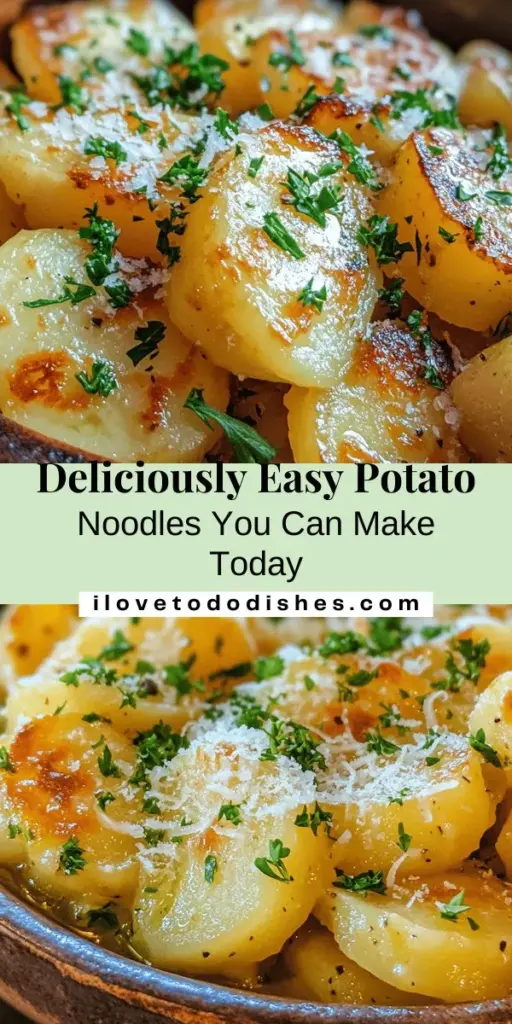Introduction
Potato noodles have been embraced by various cuisines around the world, becoming a beloved staple for many home cooks. From Italian gnocchi to Asian potato dumplings, this versatile dish offers a comforting and satisfying alternative to traditional wheat-based pasta. The appeal of potato noodles lies not just in their delightful taste and texture, but also in their ease of preparation. Whether you’re a seasoned chef or a novice in the kitchen, making potato noodles can be a fun and rewarding cooking project, perfect for family bonding time. Gather your loved ones, roll up your sleeves, and embark on this delicious culinary adventure.
The Appeal of Potato Noodles
One of the standout features of potato noodles is their unique texture. When prepared correctly, they are soft and tender, yet possess a satisfying chew that makes them distinct from other types of noodles. Unlike traditional pasta, which can sometimes be rigid or overly firm, potato noodles provide a comforting mouthfeel that is both hearty and light. Their subtle flavor allows them to beautifully absorb the tastes of accompanying sauces and seasonings, making them a perfect canvas for culinary creativity.
In comparison to other noodle varieties, potato noodles offer an appealing alternative for those looking to explore gluten-free options or simply want to try something different. The versatility of these noodles is remarkable; they can be served in various styles, from sautéed with fresh vegetables to coated in rich sauces. The potential for customization is virtually endless. You can enhance their flavor profile by incorporating different herbs, spices, or even vegetables into the dough, allowing you to create a dish that suits your taste preferences.
Ingredients Breakdown
To create the perfect potato noodles, understanding the role of each ingredient is essential. Here’s a detailed breakdown of the ingredients that come together to form this delightful dish:
Potatoes
The star of the show, potatoes, are the foundation of this recipe. When selecting potatoes for your noodles, it’s best to opt for starchy varieties, such as Russet or Idaho potatoes. These types have a higher starch content, which helps create a light and fluffy noodle. Waxy potatoes like red or yellow potatoes can be used, but they may yield a denser noodle due to their lower starch levels. Regardless of the potato type you choose, ensure they are firm and free from blemishes for the best results.
All-Purpose Flour
All-purpose flour plays a crucial role in binding the potato mixture together and providing the necessary structure to the noodles. It helps to achieve the correct consistency, ensuring the dough holds together without being overly gummy. The ratio of flour to potatoes can affect the final texture, so it’s essential to measure accurately. If you’re looking for a gluten-free option, you can experiment with alternatives such as rice flour or a gluten-free all-purpose blend.
Salt
Salt is often considered the unsung hero of cooking, and in this recipe, it enhances the overall flavor of the noodles. Adding salt to the potato mixture brings out the natural sweetness of the potatoes and elevates the dish’s taste. A pinch of salt in the cooking water when boiling the potatoes is also recommended, as it ensures the noodles are well-seasoned throughout.
Egg (Optional)
While the use of an egg is not mandatory, it can add richness and act as an additional binding agent in the dough. Incorporating an egg helps to create a more cohesive mixture, making it easier to work with and resulting in a slightly firmer noodle. If you prefer a vegan version, feel free to omit the egg or substitute it with a flaxseed meal mixture.
Olive Oil or Melted Butter
Adding a touch of olive oil or melted butter introduces moisture and depth of flavor to the potato noodle dough. This ingredient contributes to a richer taste and can enhance the overall texture, making the noodles more tender. You can also experiment with flavored oils or butters, such as garlic-infused oil, to give your noodles an extra layer of flavor.
Fresh Herbs
Incorporating fresh herbs not only enhances the flavor of your potato noodles but also adds visual appeal to the finished dish. Herbs such as parsley, chives, or basil can be mixed into the dough for a fragrant and colorful twist. Experimenting with different herbs allows you to personalize your noodles and introduce seasonal flavors.
Parmesan Cheese (Optional)
For those who enjoy a savory finish, grated Parmesan cheese can be added to the dough. This optional ingredient brings a nutty flavor and a hint of umami, enriching the overall taste of the noodles. If you’re looking to keep the dish vegetarian, ensure the cheese is sourced from a rennet-free option. Alternatively, you can leave out the cheese or use a dairy-free alternative for a lighter version.
Step-by-Step Instructions for Making Easy Potato Noodles
Boiling the Potatoes
The first step in crafting your potato noodles is boiling the potatoes. Selecting the right pot is essential; a large, heavy-bottomed pot is ideal for even cooking. Fill the pot with enough cold water to cover the potatoes by about an inch. This ensures that the potatoes cook uniformly and prevents any from becoming mushy.
When it comes to the water-to-potato ratio, a general rule is to use enough water to allow the potatoes to float freely. Adding a generous pinch of salt to the water will enhance the flavor of the potatoes as they boil.
Once the water reaches a rolling boil, add the potatoes and let them cook for about 15-20 minutes. To check for doneness, insert a fork or knife into a potato; it should slide in easily without resistance. Overcooking can lead to waterlogged potatoes, which may result in gummy noodles, so be sure to keep an eye on them.
After boiling, drain the potatoes and allow them to cool slightly. For optimal results, let them sit for about 10-15 minutes. This cooling period is crucial; it helps to evaporate excess moisture, which will contribute to a better dough consistency.
Mashing the Potatoes
Once the potatoes have cooled, it’s time to mash them. Achieving a smooth consistency is key to ensuring your noodles turn out perfectly. For this task, a potato ricer or a food mill is recommended, as they create a light and fluffy texture. If you don’t have these tools, a traditional masher or even a fork can work, but take care to avoid lumps.
Before mashing, ensure the potatoes are completely cool. Hot potatoes can create steam, leading to a gummy texture when mixed with flour. Once you’ve mashed the potatoes to a smooth consistency, it’s time to incorporate the remaining ingredients to form the dough.
As you continue to follow the steps outlined in this recipe, remember to take your time and enjoy the process. Making potato noodles can be a delightful experience, and the end result will be a comforting dish that is sure to impress your family and friends.
Making the Dough
To start your journey in creating delicious potato noodles, focus on preparing the dough correctly. Begin by boiling your potatoes until they are tender. Once cooked, peel them while they are still warm for ease of handling. Use a potato ricer or masher to ensure a smooth consistency, which is crucial for the texture of your noodles.
Techniques for Mixing the Ingredients
When combining the mashed potatoes with flour, start by adding a small amount of flour—about half of the total amount—and mix gently with a fork or your hands. It’s essential to avoid overworking the dough, as this can lead to tough noodles. Aim for a cohesive mixture where the potatoes and flour are well integrated but still tender.
If you find the dough is too sticky, it’s often a sign that you need to incorporate more flour gradually. Sprinkle additional flour, a tablespoon at a time, until you achieve the right consistency. The goal is to create a dough that is soft and slightly tacky but not overly sticky.
Rolling the Noodles
Once your dough is ready, it’s time to roll it out into noodles. Divide the dough into manageable portions to make the rolling process more manageable.
Tips for Dusting and Preventing Sticking
Before rolling, lightly dust your work surface and the dough with flour to prevent sticking. Use a rolling pin to flatten the dough evenly, ensuring that you don’t roll it too thin; a thickness of about 1/8 inch is ideal. If the dough begins to stick, don’t hesitate to add more flour to the surface and the rolling pin.
Techniques for Achieving Uniform Noodle Thickness
For uniform thickness, roll the dough from the center outwards, rotating it occasionally to maintain an even shape. You can also use a pasta machine if you have one, as it allows for consistent noodle thickness without much effort. Once rolled out, use a sharp knife or a pizza cutter to slice the dough into your preferred noodle shape—be it fettuccine, tagliatelle, or even wider noodles.
Cooking the Noodles
Cooking your potato noodles is a straightforward yet crucial step. Fill a large pot with water and bring it to a rapid boil.
Importance of Boiling Water and Salting Properly
It’s essential to salt the water generously—about one tablespoon of salt per gallon of water is a good rule of thumb. This adds flavor to the noodles as they cook. Gently drop the noodles into the boiling water, ensuring they are not overcrowded, which can lead to uneven cooking.
What to Look for to Determine When the Noodles Are Done
Potato noodles typically cook faster than traditional wheat noodles; they usually need just 2-4 minutes in boiling water. You’ll know they are done when they float to the surface and have a slightly chewy texture. To ensure perfect doneness, taste a noodle before draining.
Draining and Tossing
Once cooked, it’s essential to drain the noodles properly to maintain their texture.
Methods for Safely Transferring Noodles from Pot to Bowl
You can use a slotted spoon or a colander to transfer the noodles from the pot. If using a colander, be cautious of the steam and hot water. After draining, avoid rinsing the noodles, as this can wash away the flavor and starch that helps sauces adhere.
Suggestions on How to Incorporate Olive Oil or Butter Without Clumping
To prevent the noodles from clumping together, quickly toss them with a splash of olive oil or melted butter immediately after draining. This will add flavor and keep the noodles separate. Use a gentle folding motion to coat the noodles evenly without breaking them.
Serving Suggestions
Now that your potato noodles are ready, it’s time to think about how to serve them.
Ideas for Garnishing with Fresh Herbs
Fresh herbs can elevate your potato noodles significantly. Consider garnishing with chopped parsley, chives, or basil for a burst of color and flavor. These herbs not only enhance the dish visually but also add fresh, aromatic notes.
Optional Toppings and Sauces that Complement Potato Noodles
To create a complete meal, think about adding toppings and sauces. A simple garlic and olive oil sauce can be delightful, or you might opt for a rich mushroom sauce or a creamy Alfredo. Grated cheese—such as Parmesan or Pecorino—also complements the dish beautifully. For a more robust flavor, consider adding sautéed vegetables or proteins like grilled chicken or shrimp.
Variations and Customizations
One of the delightful aspects of potato noodles is their adaptability to various flavors and ingredients.
Suggestions for Alternative Herbs and Spices to Add Flavor
Feel free to experiment with different herbs and spices. Incorporating garlic powder, onion powder, or even a pinch of nutmeg can give your noodles a unique twist. Fresh herbs like dill or thyme can also provide a refreshing flavor profile.
Ideas for Incorporating Different Vegetables or Proteins
For a nutritious boost, try adding finely chopped spinach, kale, or roasted bell peppers into the dough before rolling it out. This not only enhances the nutritional value but also adds color to your dish. Additionally, you can toss in proteins like cooked sausage or tofu for a more filling meal.
Creative Serving Suggestions, Such as Pairing with Sauces or Stews
Potato noodles can be paired with a variety of sauces or served alongside hearty stews. Think about tossing them in a light pesto sauce for a fresh summer dish, or serve them under a rich, slow-cooked beef stew for a comforting winter meal. The possibilities are endless!
Nutritional Information
Potato noodles are not just a delicious option; they also offer several nutritional benefits.
Overview of the Nutritional Benefits of Potato Noodles
Potatoes are naturally gluten-free, making this noodle option suitable for those with gluten sensitivity. They are a good source of vitamins C and B6, potassium, and fiber. The addition of flour provides carbohydrates that give energy, while the overall dish can be easily adapted to include additional nutrients through the incorporation of vegetables and proteins.
Discussion on Calories, Carbohydrates, and Potential Dietary Adjustments
A serving of potato noodles, without any sauce or toppings, typically contains around 150-200 calories, depending on the size. The carbohydrate content will also vary based on the type and amount of flour used. For those looking to reduce carbs, consider using a portion of alternative flours, such as almond or chickpea flour, in combination with the potatoes.
Conclusion
In conclusion, easy potato noodles are a versatile and delightful dish that can be adapted to suit any palate. The simplicity of the recipe allows for culinary creativity, making it easy to customize with various toppings, sauces, and ingredients. Whether you’re serving them as a side dish or a main course, these noodles are sure to impress family and friends alike. Don’t hesitate to explore different variations and make this dish your own; the only limit is your imagination!



